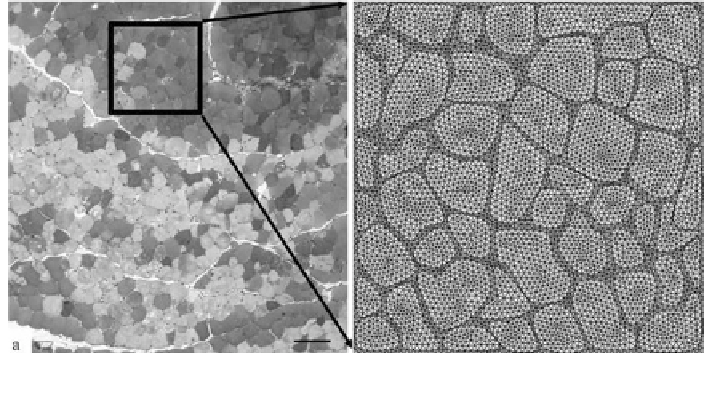Biomedical Engineering Reference
In-Depth Information
Fig. 4
Histological image and RVE mesh that was derived from it (with permission from [
9
])
simulate the transverse compression a constant load was applied by prescribing
displacements in the y-direction of nodal points at the top-edge of the macroscopic
mesh (See Fig.
2
).
Figure
3
shows a result from a simulation with the micromodel A. It was clear
that locally in a RVE there is a large variation in the deformation that individual
cells experience. The macroscopic strain energy density at the level of RVE 1 is in
the order of 500 N/m
2
, but the averaged strain energy density for individual cells
ranges from 200 to 550 N/m
2
. Taking this into account, it is not so strange that the
initial signs of tissue damage in skeletal muscle are always some individual cells
with a disrupted cytoskeleton, surrounded by perfectly healthy cells.
4 How Do Stiffness Changes Influence the Stress/Strain State
of Single Cells?
Nagel [
9
] studied the effect of cellular stiffening on the damage evolution in deep
tissue injury. Starting point for his work was the observation by Ganz and Gefen
[
7
,
14
] that rat muscles showed a 1.6-3.3 fold increase in stiffness after being
damaged (in vitro as well as in vivo). Such a rise in stiffness may lead to a
redistribution of stress and strain that might lead to a further accumulation of
damage. Based on these observations Nagel et al. spawned the hypothesis, that a
change in material properties of necrotic tissue during mechanical loading leads to
a significant redistribution of strains, so that previously unaffected regions exceed
the damage threshold. They did not apply a full multi-level analysis but used a two
step approach. First the effect of cellular stiffening was investigated at the level of
an RVE. On the micro-level a finite element mesh was created to act as an RVE.

Search WWH ::

Custom Search